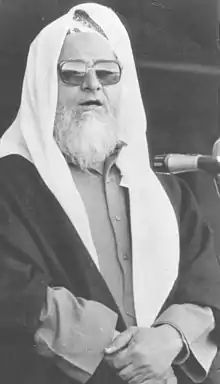Muhammad Abdullah Ghazi
Maulana Muhammad Abdullah Ghazi (Urdu:محمد عبد اللہ غازی) was a Pakistani Islamic scholar and the former Chairman of Ruet-e-Hilal Committee. He was an alumnus of Jamia Uloom-ul-Islamia. He was the first imam of Lal Masjid. He founded Jamia Hafsa and Jamia Faridia.
Muhammad Abdullah Ghazi محمد عبد اللہ غازی | |
|---|---|
 | |
| Born | 1 June 1935 Basti-Abdullah, British India |
| Died | 17 October 1998 (aged 63) |
| Cause of death | Assassination (multiple gunshots) |
| Burial place | Jamia Faridia, Islamabad |
| Nationality | Pakistan |
| Children | Abdul Aziz Ghazi Abdul Rashid Ghazi |
| 1st Chancellor of Faridia University | |
| In office 1977 – 17 October 1998 | |
| Preceded by | None (office created) |
| Succeeded by | Abdul Aziz Ghazi |
| Chairman of Ruet-e-Hilal Committee | |
| In office 1993 – 17 October 1998 | |
| Succeeded by | Muneeb-ur-Rehman |
| Signature | |
 | |
Early Life
Abdullah bin Ghazi was born on 1 June 1935 in a far-flung village of district Rajanpur, Basti-Abdullah, into the family of Ghazi Muhammad belonging Mazari tribe of Baluchistan. His father was socially active which got him in trouble many times and he was arrested by the British and sentenced to 8 years in jail. In jail, he became religious and motivated Abdullah to enrolled into a local madrassa at the age of 7 and later he moved to Karachi for further study. In accordance with his father's wish, he dedicated himself to study and graduated from Jamia Uloom-ul-Islamia in Banori-town Karachi. he was star student of Muhammad Yousuf Banuri and on his recommendation, he was appointed as the first Imam of the Lal Masjid in 1966.[1]
He created many seminaries in Pakistan including the famous Faridia University, and for the first time in Pakistan, he introduced a female madrassa education system and created Pakistan's first female seminary Jamia Hafsa. In 1993 he was appointed as Chairman of Ruet-e-Hilal committee till his assassination 1998. He had good relations with other sects and non-Muslims.[2]
Lal Masjid
He was endowed with great qualities of oratory and his Friday sermons used to attract thousands of the faithful to the mosque. Before Faisal Mosque's completion Lal Masjid was the first and only Central Mosque of Islamabad and President Muhammad Zia-ul-Haq was a regular visitor of the mosque. upon completion of the Faisal Mosque, Zia ul Huq wanted Maulana Abdullah to take a position at the newly built mosque as its first Imam but Maulana did not take the offer.[3]
Soviet War in Afghanistan
During the Soviet war in Afghanistan (1979–1989), the Red Mosque played a major role in recruiting and training Mujahideen to fight alongside the Afghan Mujahideen against Soviet troops. A few months before his assassination in 1998 Moulana Abdullah together with Moulana Zahoor Ahmad Alwi, Qari Saeed-ur-Rehman and some other scholars toured Afghanistan. Maulana took his rebellious son (Abdul Rashid Ghazi) especially with him. This delegation met Mullah Omar, Osama Bin Laden. and Dr Ayman Al Zawahiri [4]
Assassination
His biographer, Riaz Mansoor, states that Maulana had a routine every day whereby he would walk to a seminary for giving lectures (7 km away from the Red-Mosque). On the day of his assassination, he walked to his Madrassa Jamia Faridia also known as The Al Faridia University and returned by car at noon. As he got out of the car, his elder son Maulana Abdul Aziz Ghazi approached him and spoke to him. When Moulana approached his house, a man standing in front of the door walked towards him and pulled out a gun and opened fire until the magazine was empty, badly injuring Moulana. Afterwards, he fired at Abdul Aziz, who barely escaped death. The assassin escaped with the help of an accomplice waiting outside in a car. Moulana died of his injuries on the way to the hospital.[5]

FIR and Case
Due to a lack of trust in Pakistan's legal system, his elder Son refused to lodged FIR, but his younger son, Abdul Rashid Ghazi lodged the FIR and the police investigated the case. After a relentless effort, a man was arrested and afterwards, during the ID parade, an eye witness identified the assassin. However, he was released the next day without reason. Abdul Rashid Ghazi protested against the release and warned the police of legal action if the suspect was not arrested soon. With Ghazi increasing pressure on police, he was asked to withdraw the case or face the fate of his father. According to his friend, this was a turning point in Ghazi's life, and he became disillusioned with the system.[6]
Memoir
In 2005, A Memoir was Published detailing Maulana's life under the name Hayat Shaheed E Islam By Riaz Munsoor
References
- Biography Book: Hayat Shaheed E Islam By Riaz Munsoor
- "شہیداسلام مولانا عبداللہ شہید شخصیت و کردار۔۔۔تحریر مولاناتنویراحمداعوان". Shaffak (in Urdu). 18 October 2016. Retrieved 8 February 2021.
- حضرت مولانا عبداللہ غازی رحمۃ اللہ علیہ (20 October 2016). "حضرت مولانا عبداللہ غازی رحمۃ اللہ علیہ". ہم سب. Retrieved 8 February 2021.
- "Lal Masjid: a history". www.thenews.com.pk. Retrieved 8 February 2021.
- Lal Masjid : A Brief History.
- Lal Masjid : A Brief History.
- Paracha, Nadeem F. (3 November 2013). "Red handed". DAWN.COM. Retrieved 8 February 2021.